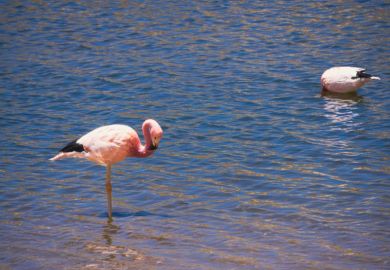Author: Lee Alan Dugatkin
Edition: Second
Publisher: W. W. Norton
Pages: 600
Price: £41.99
ISBN 9780393931693
The study of animal behaviour provides a gateway into the analysis of almost every level of biology, from molecular genetics to immunology, physiology, neurobiology and evolution. Thus it must be extremely challenging for an author of an entry-level text to strike the right balance between description of the behaviour itself, with all its fascinations, and the more pragmatic hard-nosed approach about what lies beneath this surface. Dugatkin's second edition just about gets the balance right and tries hard to move away from the strictly ethological approach that has dominated the field and its textbooks in past decades. The book reveals a richly illustrated panoramic view of animal behaviour and, where it can, it also provides examples of the physiological, neurobiological and molecular genetic mechanisms that may underlie it.
One theme that percolates through the book is the difference between proximate and ultimate causes of behaviour. Proximate causes are the answers to "how?" and "what?", whereas ultimate causes tend to answer the more evolutionarily loaded question of "why?". The chapters cover all the usual topics - learning, cultural transmission, kinship, sexual selection, foraging, aggression - and there are chapters on subjects that one does not usually see in this type of text - for example, animal personalities and ageing and disease. I found myself reading the behavioural examples with a "golly gosh" kind of fascination. I was a bit less impressed when Dugatkin moves away from behaviour and describes the mechanisms, and here lies my one criticism.
For example, when discussing molecular genetics, he doesn't always get it quite right. Take ultraviolet vision in birds, which he discusses at some length, and the single gene that encodes the UV pigment. His description stimulated me to follow up some of his references and, indeed, I found that he had got the story slightly wrong (pigeons do have UV pigments). The pigments were manipulated in vitro, not in vivo as he'd implied, and he had given me the impression that genes can be moved in and out of these bird species (which they can't, yet). He could have picked from a host of better examples where single gene changes affect behaviour, and which you can prove do so, by modifying the gene and putting it back into the host organism, as one can do in rodents and insects.
So, overall, this book would cover the first-year biology curriculum as well as A level. It would not be suitable for more advanced courses, as the depth is lacking in the examples given. This is not a criticism, as Dugatkin's text is clearly aimed at the former readership and, indeed, can be enjoyed by anyone who has an interest in the beauty of animal behaviour. And therein lies its strength.
Who is it for? Sixth-formers, first-year biology undergraduates and anyone interested in animal behaviour.
Presentation: Excellent.
Would you recommend it? Yes.
Register to continue
Why register?
- Registration is free and only takes a moment
- Once registered, you can read 3 articles a month
- Sign up for our newsletter
Subscribe
Or subscribe for unlimited access to:
- Unlimited access to news, views, insights & reviews
- Digital editions
- Digital access to THE’s university and college rankings analysis
Already registered or a current subscriber?



